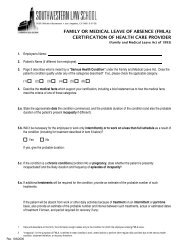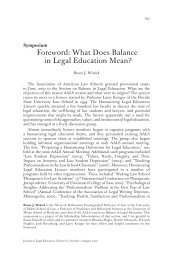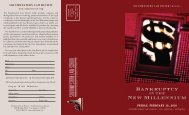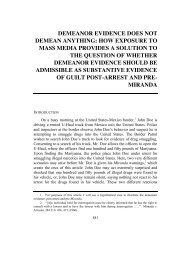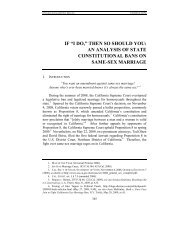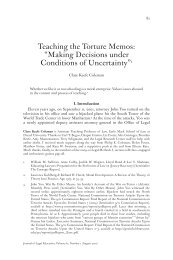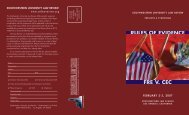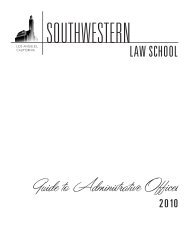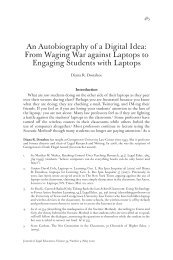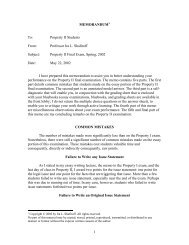128 J. INT’L MEDIA &ENTERTAINMENT LAW VOL. 4,NO. 2The judge directed the jury that all defence arguments were legallyunsound or irrelevant, and in particular that “th<strong>is</strong> case <strong>is</strong> not about art<strong>is</strong>ticfreedom or freedom of expression or anything of that sort. Youmay have heard it described as a test case. Nothing could be furtherfrom the truth. Th<strong>is</strong> <strong>is</strong> a very narrow and specific case. Please don’tbe deluded into imagining that you’re trying the contemporary art establ<strong>is</strong>hment.It provides no defence whatsoever that the drawings inquestion may be worth more than the originals or, for that matter,that they may in some manner provide the defendant with a principalsource of h<strong>is</strong> livelihood. Whether or not the defendant understood thelaw <strong>is</strong> immaterial.” It was a direction to convict.Engl<strong>is</strong>h juries, especially at the Old Bailey, fiercely resent beingtold by trial judges what to decide. They returned within fifteen minutesa unanimous verdict of not guilty on all counts. Outside in the OldBailey street, members of the jury came out to shake Boggs’ hand andsay “It was the correct verdict. We loved your work.” Indeed: thejury’s judgement had been persuasively guided by Boggs’ art lawyer’sdeep understanding and advocacy of h<strong>is</strong> art bartering practice: at once,conceptual, performative, and graphically representational. 782007/11 USA: Kelley v. Chicago Park D<strong>is</strong>trictIn 1984 Chapman Kelley 79 was granted formal perm<strong>is</strong>sion by theChicago Park D<strong>is</strong>trict to use a parcel of land in Grant Park to createan original artwork: Chicago Wildflower Works, 1984. 80 Twentyyears later the Chicago park authority bulldozed half of Kelley’s siteand replaced h<strong>is</strong> wildflowers with trees, without h<strong>is</strong> knowledge or consent.Kelley filed suit claiming violation of h<strong>is</strong> statutory moral rightsunder federal law: the V<strong>is</strong>ual <strong>Art</strong><strong>is</strong>ts Rights Act 1990 (VARA). 8178. One certain legacy of the case <strong>is</strong> that, soon after their failed prosecution ofBoggs under forgery and counterfeiting (but not copyright) leg<strong>is</strong>lation, the Bank ofEngland for the first time included on its Treasury Notes the international copyrightdeclaration: © THE GOVERNOR AND COMPANY OF THE BANK OF ENGLAND.79. Chapman Kelley was born in San Antonio, Texas, USA, in 1932. He <strong>is</strong> a painter,draftsman, art<strong>is</strong>ts’ rights activ<strong>is</strong>t, art dealer, lecturer and art teacher.80. It compr<strong>is</strong>ed 66,000 sq. ft. into which Kelley planted forty-five different kindsof yellow and purple blooming flowers that were tended by volunteers under h<strong>is</strong> direction,and at h<strong>is</strong> own expense, for twenty years. Kelley described the work as “a sculptureof native flowers, gravel, and steel . . . created with the approval and agreement ofthe Chicago Park D<strong>is</strong>trict.” See http://www.chapmankelley.com/asset.asp?AssetID=37996&AKey=jlbdk6w281. One hundred sixty four countries have now enacted moral rights leg<strong>is</strong>lation,giving creative art<strong>is</strong>ts two basic rights: to claim (or deny) authorship of their work(so-called paternity right); and to object to any mutilation or deformation or othermodification of, or other derogatory action in relation to, their work which wouldbe prejudicial to the author’s honour or reputation (so-called integrity right). The United
WHAT IS ART? 129First tried in 2007/8, 82 the heart of the case lay in the question ofwhether Kelley’s work was an artwork entitled to protection underVARA or whether it was merely landscaped public parkland—andtherefore not entitled to such protection. VARA only gives art<strong>is</strong>tsmoral rights over certain forms of art, specified in the US CopyrightAct 1976. The initial trial judge expressed sympathy for, and understandingof, the development in the late 20th century of radicallynew art practices and forms, commenting: “There <strong>is</strong> a tension betweenthe law and the evolution of ideas in modern or avant-garde art; theformer requires leg<strong>is</strong>latures to [classify] art<strong>is</strong>tic creations, whereasthe latter <strong>is</strong> occupied with expanding the definition of what we acceptto be art. While Andy Warhol’s suggestion that ‘art <strong>is</strong> whatever youcan get away with’ <strong>is</strong> too nihil<strong>is</strong>tic for the law to accommodate, neithershould [moral rights laws] be read so narrowly as to protectonly the most revered work of the Old Masters. In other words, the‘plain and ordinary’ meanings of words describing modern art arestill slippery.” 83 And so the court ruled that Kelley’s work was inlaw a sculpture, or three-dimensional artwork; and also a paintingthat “corralled the variegation of wildflowers in bloom into pleasingoval swatches”. Kelley was rightly pleased with th<strong>is</strong> enlightened initialjudgment, commenting: “Th<strong>is</strong> ruling redefines legally what can be fineart, what it can be made of, and that art<strong>is</strong>ts themselves make thesedec<strong>is</strong>ions.”However, not all artworks are entitled to copyright and thereforemoral rights protection; only those that pass the legal ‘originality’test required by copyright law (of most countries, including the US),which courts determine in each case. In Kelley’s case the trial courtexpressed difficulty in understanding what was original about h<strong>is</strong>work because he was not “the first person to ever conceive of and expressan arrangement of growing wildflowers in [an] ellipse-shapedenclosed area”. 84 The judge further ruled that Kelley’s work was‘site-specific’ and, as such, would not be entitled to moral rights protection(even if it had passed the legal ‘originality test’) because UScase law had decided in 2006 that site-specific artworks—whose integ-States introduced statutory moral rights into federal law through VARA, following theU.S. government’s joining the Berne Convention in 1989. VARA amends the federalCopyright Act 1976 by inserting moral rights of paternity and integrity, but only forliving v<strong>is</strong>ual (not other creative) art<strong>is</strong>ts.82. Kelley v. Chicago Park D<strong>is</strong>trict, No. 04 C 07715, 2008 WL 4449886 (N.D. Ill.,Sept. 29, 2008), aff’d in part, rev’d in part, 635 F.3d 290 (7th Cir. 2011).83. Id. at6.84. Id.



